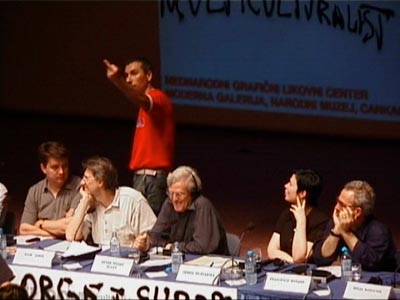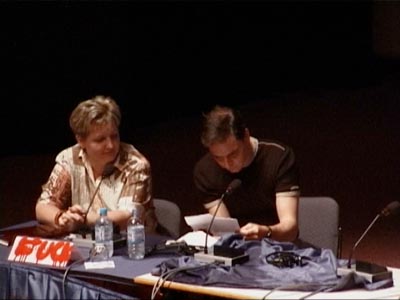E-MAIL INTERVIEW WITH OLE BOUMAN by Ur¹a Jurman
U. J.:
What was your vision of Manifesta 3?
O. B.: As I said at the press conference on June 22, I think one has to distinguish at least three different stages. We started by writing a proposal that implied a strong engagement within the social and political realm. Borderline syndrome, energies of defense - a hot issue in a changing culture. The statement was also a call for entries, an attempt to invite Europeans to address the issue of defense and protection in the post-Cold War Europe.
So far so good. But the actual production of an exhibition of contemporary art revealed major differences in curatorial visions. Big questions came to the fore. What makes a good show: a series of individual works or an overall narrative? Can artists be asked to change the subject of their work if it becomes too threatening to the local situation? Should the core of the exhibition be confined to some traditional museum venues? Are we able to cross-fertilize visual art with energies from other fields? Wouldn’t it be better to restrict ourselves to less artworks in order to enhance the local embedding through more contextual works? Is it possible to conceive a show that interfaces cyberspace and the city of Ljubljana? In sum, the future of curatorship was at stake. I have to admit, I lost the battle. In the end we realized we were living in incompatible worlds and, moreover, it was three to one. As for the concept and the participating artists, I think M 3 was pretty convincing. As an exhibition, it could have been much stronger. The venues were predictable, the visitor’s experience was hardly acknowledged, the mix of different media was unstable, the spatial trajectories were confusing and the overall narrative connecting the show to the concept was lost. What remains is an impressive range of singular powerful artworks.
I have tried several times to distance ourselves from the personalistic approach and to use other angles to get a grip on the whole. Since we touched upon larger cultural issues - ‘energies of defence’, ‘protection mechanisms’, ‘drawing a line’, ‘doing something for Europe’ etc. - it did not seem good to fall back upon an enumeration of a long series of private universes. We have to engineer ties, clusters, thematic crossovers and the like, both intrinsically and related to the spatial setting. I believe an exhibition is an essay, an intervention. In the end it is all about the exhibition which is a physical fact and an artistic and intellectual experience.
 from
M3 press conference
from
M3 press conference
U. J.: You said that the future of curatorship was at stake. In your text Ten Points towards a New Practice of Curating which is published on Virtual Manifesta Web page (which was your response to curators’ disagreements) you are - among other things - saying that ‘…nowadays circumstances in production and also reception of art need new concepts and practices of curating.’ Could you be more specific and how is that possible to realize in the frame of such a representative event as Manifesta?
O. B.: What I say is: The traditional conditions for exhibiting art are all in the process of tremendous transformation. The status of the maker, the image, the object, the display, the space, the institution and perhaps most of all the reception is changing to a degree of producing difficulties to recognize them as such. In these circumstances the practice of curating art both shows and requires completely different concepts. What I mean is that, for a very long time, making an art show relied on a couple of basic concepts: the space, the time-span, images on display. We are living in a time in which the basic concepts turn out to be not so basic anymore. I feel visual art is pretty slow in adapting to new configurations of cultural production.
With regard to the objection that these kinds of reflections are not appropriate for a representative event like M, I can only say that it is the organization that makes it representative. Intrinsically, M is an experiment and as such, shouldn’t be representative. How can you represent something existing when you want to do something new? This paradox is a key factor for understanding the paralyzing conditions of much of cultural policy today.
U. J.: In relation to exploring and developing possible ways of presenting contemporary art, you also stressed the importance of engagement of the local environment. This issue is especially important in regard to M, because connecting with the local context is supposed to be one of its specifics. How do you see M 3 in relation to this intention - what was the exchange between the locality and the event? What should be different in your opinion? How would you use the city as a medium?
O. B.: This is a vast
field that would take a book to answer thoroughly. I just want to say
here that, while being in the process of producing M 3, we were in dialogue
with a variety of institutions that in the end were all left out: the
Institute of Architecture, the Chamber of Commerce, Metelkova, Ljudmila
at an early stage, the Film Festival and so on. Suppose what would have
happened to Ljubljana, when all these and other institutions would have
become part of M? It would have meant that the event would have transcended
to a cultural condition that can be lasting. But maybe this is already
the case I am not aware of.
U. J.: One of the ways in which you tried to connect with and engage
the local community was a call for proposals which you distributed in
December 1999. What happened with the materials which people sent to your
call for proposals? It was supposed to be published and presented.
O. B.: You are right,
but the harvest was not that exceptional. What we thought was very relevant
is published in the M 3 book.
U. J.: What can you say about the projects presented at
Virtual Manifesta - what connects them? How are they different from
the ones presented at Manifesta 3? Were those projects rejected by the
other three curators?
O. B.: What I tried to do is to collaborate with different artists who produce works that are complimentary in their reaction to the main theme: energies of defence. They are working in the fields of architecture, satellite technology, network platforms or political activism. They all share a strong interest in how borderline transgression can become a cliché and how one can develop new, active and progressive forms of protection of value systems.
This brings me to another point which has to do with curatorial strategy. Contemporary art barely needs a deductive approach. I have seen too many shows that are the result of induction. They are very empirical, based on observations only. I think curating is more than showing your observations. It is about taking risks through producing a limited amount of very conscious contestable combinations of works, physicalities, ideas. By putting the participating artists into a curatorial web-format, I take the risk of reducing them to an overall concept. I do think however that their works are on display in their own right. Additionally, they contribute to a more general exploration of the theme.
 from
M3 press conference
from
M3 press conference
U. J.: You state that curating should be more than just presenting observations. How do you then perceive numerous video documentaries at M 3 in which artists are merely observers - as if life speaks strongly enough for itself and doesn’t need any interpretation?
O. B.: The example of those video works is similar, but not exactly what I meant. I agree that making art is more than showing a documentary or just long shots of ‘reality’. In terms of curating, I mean that a curator should moderate and that is and act of authorship. I don’t think that it is enough to be a filter for ‘good work’, a kind of selection device. An exhibition is a story, an experience and a subjective statement. A curator is responsible and not a neutral messenger.
October-November 2000
(Ole Bouman - kustos, publicist, glavni urednik revije
Archis / curator, essayist, editor-in-chief of the magazine Archis)